5 Famous Artists Who Were Migrants and Other Stories
As long as there have been artists, there have been migrant artists. Like anyone else, they’ve left their homeland and traveled abroad for many...
Catriona Miller 18 December 2024
2 September 2024 min Read
Let’s ride a tiger! Definitely not! We should never try to ride a tiger, and Rousseau does not suggest it either! It would be horrible (especially for the person I think). The art of Henri Rousseau is so exotic though that you could be forgiven for thinking it’s possible. Rousseau takes us to faraway locations in the tropics when we look at his art. These places are beyond merely distant: they are exotic flights of fancy and we find ourselves among the fantastical. Rousseau’s subjects have an otherworldly quality, as though caught in a dream, despite also being familiar.
If you read about Rousseau before viewing his art, you might imagine it to be not very interesting. He was the son of a tinsmith and briefly studied law after finishing school. Next, he spent four years in the army. After that he became a tax collector (his nickname was Le Douanier because of this last job). Even during his time in the army, he didn’t leave France, so he didn’t visit any tropical lands. In fact, Rousseau didn’t experience any foreign travel at all! So where could all these amazing pictures have sprung from?

Rousseau lived in an era called La Belle Époque, sandwiched between the end of the Franco-Prussian War (1871) and the beginning of World War I (1914). It was coterminous with the latter part of the Victorian era in Britain. This era saw a thriving culture of fashion, architecture and the arts. The Eiffel Tower was completed in 1889, the can-can was danced at the Folies Bergère, and Toulouse-Lautrec was producing his famous posters. Parisian life, teeming with the nouveau-riche, was a melting pot of hedonism characterized by celebration and revelry, at least among the more affluent upper classes.
Also during this period, France expanded its boundaries in terms of colonial occupation of foreign lands. Known as New Imperialism, the focus was on Africa. European powers sought to invade and occupy African territories in order to have access to its resources. They also sought to spread the Christian message through missionary work, and gain impressive reputations at home as imperialist entrepreneurs. At this time the abolition of slavery was a significant reason to push into Africa. Spring boarding off the Brussels Anti-Slavery Conference of 1889-90, the issue was brought to public attention. Importantly, it served to bind colonial rulers to its tenets. It also informed the League of Nations founded in 1920, and the United Nations founded in 1945.
While this is all interesting and important historical information, how does it explain Rousseau’s amazing views of the tropics? France already had colonial establishments in India, so ideas of “otherness” were not new. The world however was becoming increasingly industrial and interconnected. It seems inevitable that ideas, objects, art, and anything else that you can think of would have eventually made their way back from the colonies to the homeland and more conspicuously than before. These items might have appeared more frequently in exhibitions, museums, at conferences, in shops or in people’s homes.
Combine an influx of unusual and tropical goods with visits to places like the Jardin des plantes in Paris and you have the perfect recipe to stimulate an already active imagination. In addition, though Rousseau never left France, he knew plenty of people who had. He listened to accounts of foreign travels told by his soldier friends. He read the often illustrated books of those who traveled far and wide, and visited museums, gardens and exhibitions. His imagination did the rest.
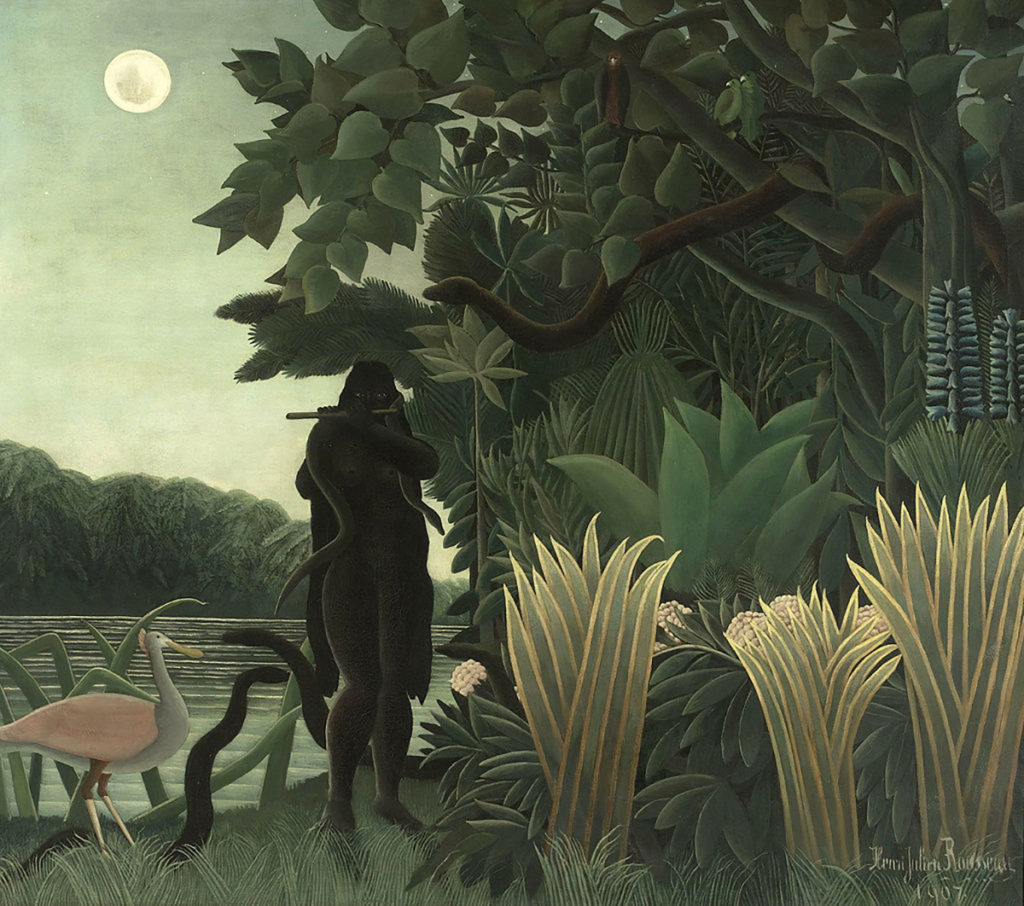
Rousseau’s self-taught style of art is known as naïve. With no formal education in art it is unsurprising that Rousseau did not use the techniques of trained artists. This is his strength! It is what makes his work so interesting and so different from other art of the time. His paintings contain vast amounts of literal detail – a far cry from the Impressionist movement that went just before him. Take the leaves of the trees in The Snake Charmer: each leaf is crafted precisely rather than “represented” using a conventional technique. Rousseau’s work here is more like a botanical illustration rather than art. It is art of course! There is significant overlap between art and illustration – a discussion for another time perhaps.
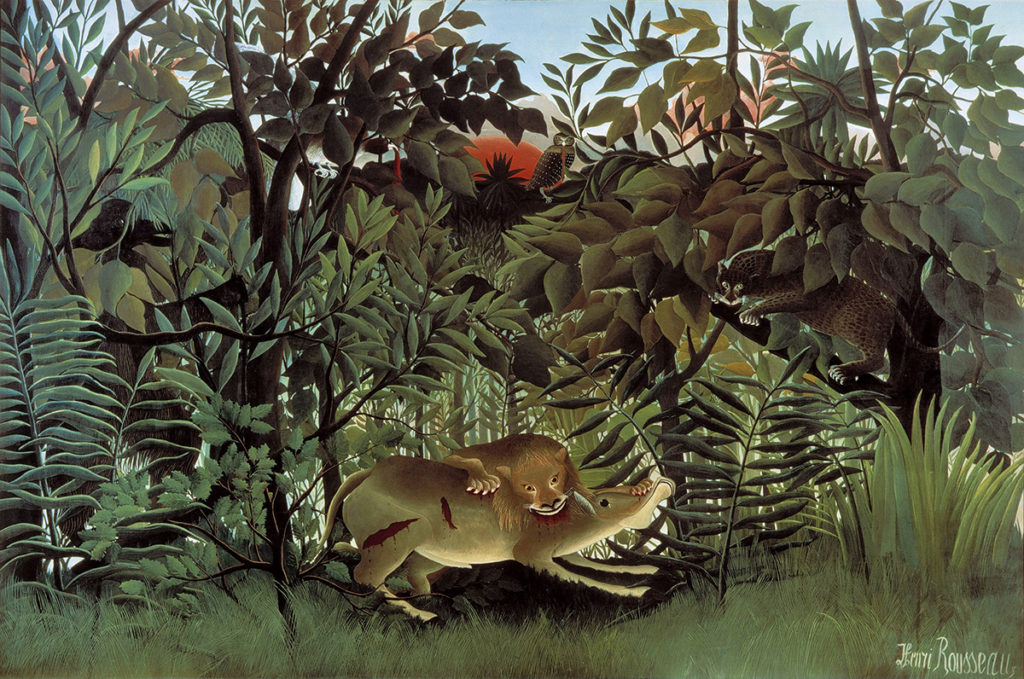
Since Rousseau did not learn conventional techniques for mixing color, he created his own distinctive palette. His bright colors are reminiscent of the felt tip pens that we give to children, and which endow any creations with happy, uplifting hues. Rousseau does not shy away from using highly saturated pigments to give his foliage the lushness of a jungle after rain, or to bring out fallen fruit, flowers, or blood.
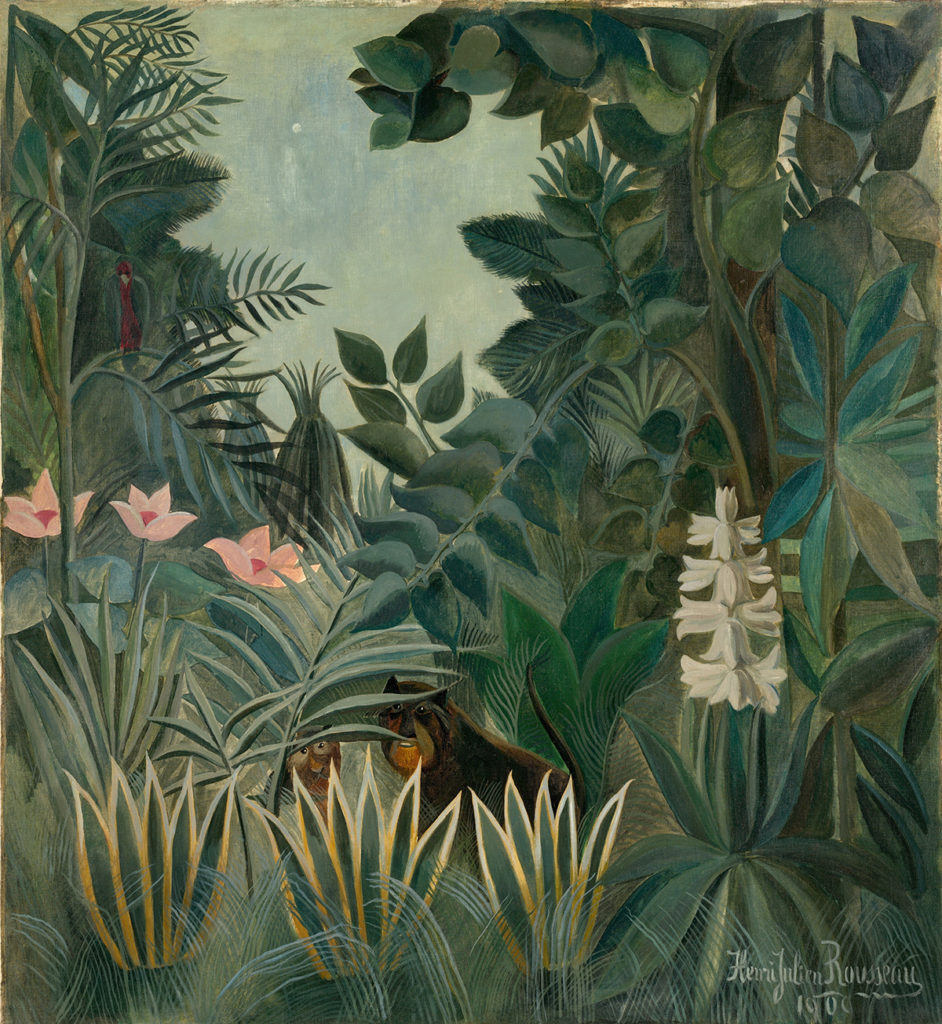
Rousseau’s painting style also lacks formal perspective. In The Equatorial Jungle above, the plants and animals are layered, creating a sense of depth. Anyone who has used Adobe Photoshop will know exactly what I mean. For those who haven’t had experience of Photoshop, do you remember the old overhead projectors of the 1970s and 1980s? You could layer acetate sheets one over another until a complete image emerged. Rousseau’s paintings have this kind of quality. If we selectively took layers away, we could remove the monkeys, or the pink flowers, or the layer with the bird in it. It is because we can see that one thing lies behind another that the jungle recedes into the picture plane.
Also, I have to ask… Is it just me or do those cute little monkeys look like they’re having a really serious conversation about something top secret?
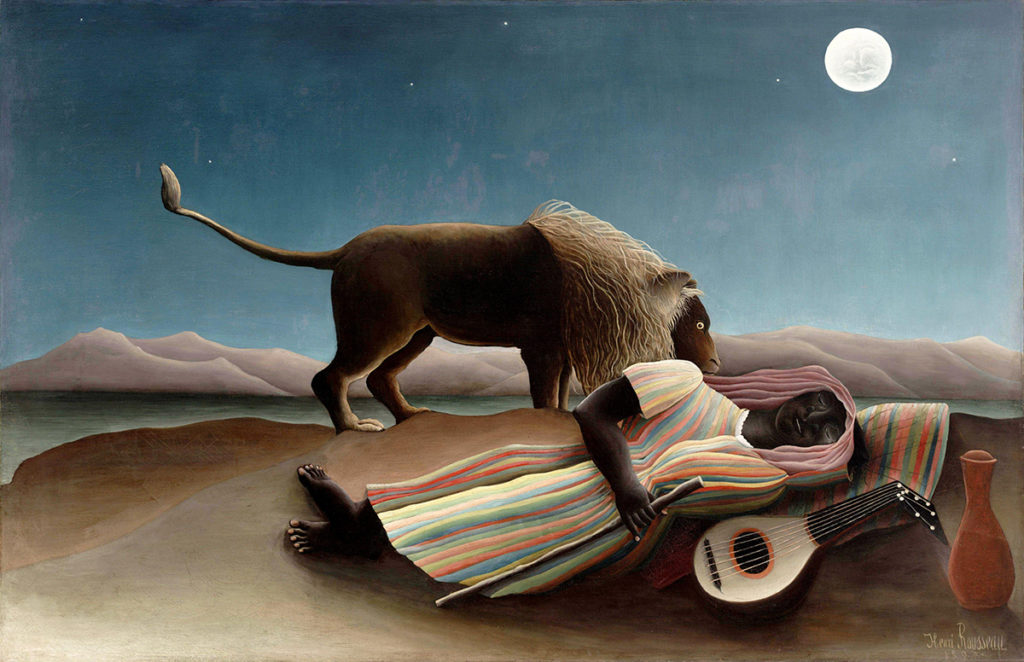
We’ve talked a little bit about painterly technique, form, color and perspective, so now let’s have a look at motion. Only Tiger in a Tropical Storm (surprised!) has any sense of dramatic movement. Rousseau has implied the direction of the storm using diagonals. The wind is blowing the rain and foliage the same way. Even the lightning forks across the sky in the same direction. In The Sleeping Gypsy above though we have serenity, calmness, and virtually no sense of motion at all. This is actually perfect. Who has not had a dream where motion is changed somehow? We dream of falling, flying, bounding and floating. We even dream of being unable to move when we need to. Why not also dream of complete stillness?
The lion appears alert, tail held aloft, back legs bent as if contemplating whether to spring away suddenly. The lion’s eye is wide, his ears are forwards and his head is lowered to investigate the sleeping figure. The dry, expansive landscape behind the figures frames the tension between them. A huge night sky looks down on a perfectly captured moment that is more like a dreamscape.
The woman is unaware of the lion at her shoulder. She is deeply asleep, and perhaps herself dreaming of some faraway land. She wears a serene smile as she lies in slumber, her lute and water jar put to one side. Her pastel clothing is luminous under the full moon. The big, brown lion is almost as big as she is, but we do not recoil in horror. Instead, we are drawn in to the static capture of a moment. All is perfect and she can’t be hurt because time is frozen.
In dreams, we often face our vulnerabilities as innocently as if we were children again. Rousseau’s art from the perspective of the naïve provides a way into this idea. It brings us closer to our earlier, less encumbered selves. The only movement in this painting is the slow rise and fall of the woman’s chest, the soft flare of the lion’s nostrils, and the slow arcing of the moon across a vast sky.
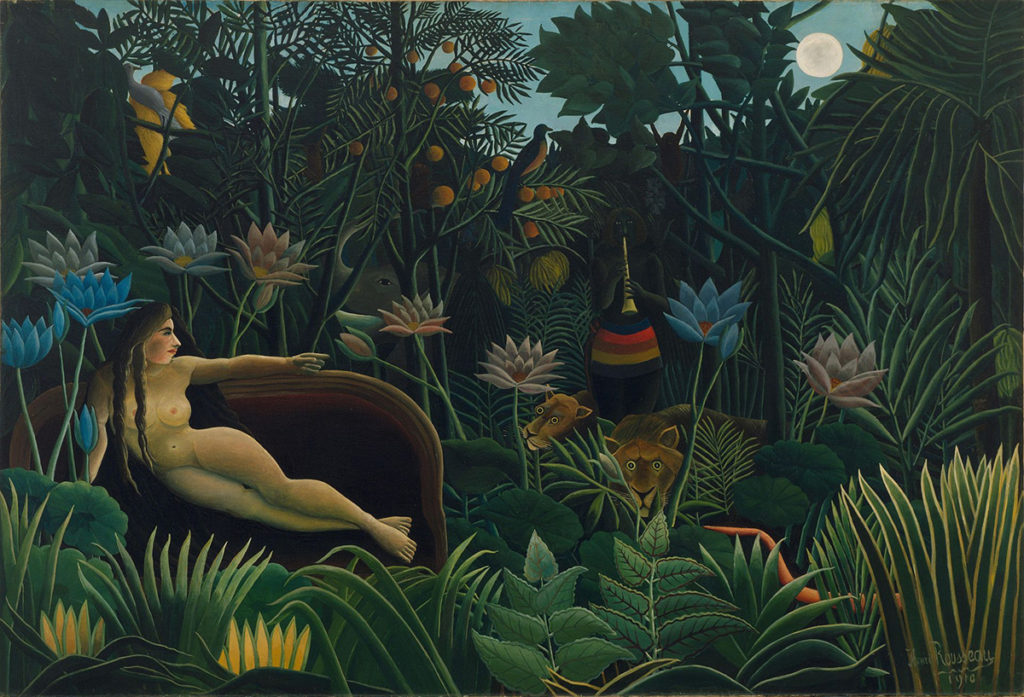
DailyArt Magazine needs your support. Every contribution, however big or small, is very valuable for our future. Thanks to it, we will be able to sustain and grow the Magazine. Thank you for your help!